
Leaving Santa Fe, we took a backroads route south that went through some beautiful country and funky, cute towns — Cerrillos and Madrid. Then we hooked up with Route 66, finally, just east of Albuquerque.
I had been
trying to find old Route 66 on several maps — it wasn't easy. Most
sections are not marked because they are part of newer highways. 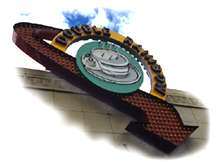 But,
here it was! Another dream of mine is to someday travel the whole length
of Route 66, at least what remains of it. For now, this little stretch
would have to do. And right away, its appeal and personality were evident,
even after all the years and changes to its original form. Neat neon deco
signs above oh-so-cool diners, motels and restaurants. A paradise of road
art.
But,
here it was! Another dream of mine is to someday travel the whole length
of Route 66, at least what remains of it. For now, this little stretch
would have to do. And right away, its appeal and personality were evident,
even after all the years and changes to its original form. Neat neon deco
signs above oh-so-cool diners, motels and restaurants. A paradise of road
art.
 Continuing
through Albuquerque we saw a few "tall" buildings, but would hardly have
known it was a large city. We went to the Old Town Plaza, which was similar
in design and feel to Santa Fe's Plaza. Beautiful trees and walkways around
a bandstand, surrounded by nice shops, galleries and a Spanish cathedral.
Our original plan was to spend a night in Albuquerque, but because we
were there so early in the day, and the weather was gloomy, we decided
to keep heading south. Again, some regrets about that, because we missed
a lot of Albuquerque's beautiful and historic areas. We will be back!
Continuing
through Albuquerque we saw a few "tall" buildings, but would hardly have
known it was a large city. We went to the Old Town Plaza, which was similar
in design and feel to Santa Fe's Plaza. Beautiful trees and walkways around
a bandstand, surrounded by nice shops, galleries and a Spanish cathedral.
Our original plan was to spend a night in Albuquerque, but because we
were there so early in the day, and the weather was gloomy, we decided
to keep heading south. Again, some regrets about that, because we missed
a lot of Albuquerque's beautiful and historic areas. We will be back!
It was US 25 south for the next 225 miles to our next destination: Las Cruces. The drive was uneventful, not as scenic as northern New Mexico, but we did see some unusual, dramatic cloud formations hanging over the Los Pinos Mountains that ran north-south along many miles of the highway.
Why Las Cruces? Well, mostly because it was close to White Sands National Monument (funny how some of these huge areas are called "monuments" as opposed to parks — I don't know what the distinction is). White Sands was one of my "must-see" places on this trip. The pictures I'd seen of it were beautiful and intriguing. Of course, those were taken on brilliant, sunny days. And that wasn't exactly the situation now.
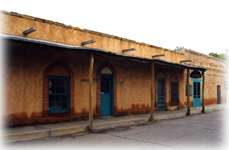 We
would spend two nights in Las Cruces; I was hoping that the sun might
reappear before we got to White Sands. Meanwhile, we hung out around town.
We
would spend two nights in Las Cruces; I was hoping that the sun might
reappear before we got to White Sands. Meanwhile, we hung out around town.
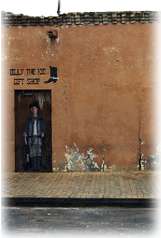 Peter played
golf at New Mexico State's course (too cold for me), while I went antiquing
— there were several nice shops clustered together. Then I drove
to Old Mesilla, an historic Spanish village only a mile or so from Las
Cruces. Another pretty plaza, with a wannabe Mexican band playing in the
center. More nice shops; one was named after Billy the Kid and located
in the courthouse where he was tried and sentenced to hang in 1881. The
area was almost deserted while I was there. Later in the day, we stopped
at a construction site where new adobe homes were in progress. It was
fascinating seeing how they are built. Hmmm, nice retirement homes.
Peter played
golf at New Mexico State's course (too cold for me), while I went antiquing
— there were several nice shops clustered together. Then I drove
to Old Mesilla, an historic Spanish village only a mile or so from Las
Cruces. Another pretty plaza, with a wannabe Mexican band playing in the
center. More nice shops; one was named after Billy the Kid and located
in the courthouse where he was tried and sentenced to hang in 1881. The
area was almost deserted while I was there. Later in the day, we stopped
at a construction site where new adobe homes were in progress. It was
fascinating seeing how they are built. Hmmm, nice retirement homes.
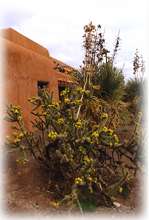 We
couldn't wait any longer. We headed to White Sands the following gray
morning. There was a beautiful adobe Visitor's Center where we learned
more about this strange phenomenon: 275 square miles of ever-changing
gypsum sand dunes. We headed into the park on the eight-mile drive; this
is the only access to the dunes by car.
We
couldn't wait any longer. We headed to White Sands the following gray
morning. There was a beautiful adobe Visitor's Center where we learned
more about this strange phenomenon: 275 square miles of ever-changing
gypsum sand dunes. We headed into the park on the eight-mile drive; this
is the only access to the dunes by car.  We
walked the Big Dune nature trail, going up and down several large dunes.
The vegetation is beautiful in contrast to the white sand. And this gypsum
sand is so soft and fine-grained, the most luxurious sand to have under
foot. If only I could ship some home to our beach!
We
walked the Big Dune nature trail, going up and down several large dunes.
The vegetation is beautiful in contrast to the white sand. And this gypsum
sand is so soft and fine-grained, the most luxurious sand to have under
foot. If only I could ship some home to our beach!
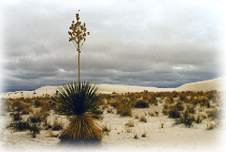 Climbing a dune, you expect to see ocean as you go over the crest. Then,
surprise: just more miles and miles of sand. Most of the animals here
were nocturnal; we found some tracks in the sand — probably from
a fox or coyote.
Climbing a dune, you expect to see ocean as you go over the crest. Then,
surprise: just more miles and miles of sand. Most of the animals here
were nocturnal; we found some tracks in the sand — probably from
a fox or coyote. 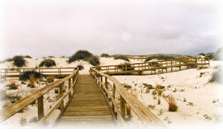 A
long winding boardwalk forms another trail with interesting scenes. As
the sands shift in the wind, plants are uprooted and then adapt and grow
back into the gypsum from their new positions. This creates some interesting
effects.
A
long winding boardwalk forms another trail with interesting scenes. As
the sands shift in the wind, plants are uprooted and then adapt and grow
back into the gypsum from their new positions. This creates some interesting
effects.
 At
the end of the drive was the strangest camping area I'd ever seen. Very
otherworldly; especially this day, with the pearl-gray skies meeting the
white-gray dunes.
At
the end of the drive was the strangest camping area I'd ever seen. Very
otherworldly; especially this day, with the pearl-gray skies meeting the
white-gray dunes. 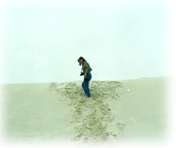 It
was almost disorienting, it was hard to know what you were seeing. As
we headed back out of the dunes, a sudden movement caught my eye. What
..? Bee beep! It was a roadrunner! sprinting across the drive,
just in front of us. So they actually do exist — very neat.
It
was almost disorienting, it was hard to know what you were seeing. As
we headed back out of the dunes, a sudden movement caught my eye. What
..? Bee beep! It was a roadrunner! sprinting across the drive,
just in front of us. So they actually do exist — very neat.
We went through Alamagordo and then south on 54. It was an interesting, remote drive through southern New Mexico. We arrived in El Paso sooner than we thought ... crossed back over the Rio Grande into New Mexico for one last stop in Santa Teresa.
Here was the War Eagles Air Museum. A WWII veteran we had met in Las Cruces had told us about this out-of-the-way place. Because my father was a B-26 top turret gunner in the Army Air Corps during WWII, I wanted to stop. We were the only visitors. We met a nice man who worked there, and told some interesting stories. They have collected some beautiful old planes, cars and other war memorabilia. This was a nice tribute to that "greatest generation" of men and women — it made me appreciate my father even more.
Back to El Paso. We were shocked at how sprawling, densely developed and mountainous it was. It looks so huge because you are actually seeing much of Ciudad Juarez, Mexico, just across the narrow Rio Grande. We spent the last night in a motel here, then took a flight home the next morning.
What a long, great trip it had been. Over 14 days, we had stayed in 11 different places, covered 2500 miles and seen so much beauty and grandeur. But there was so much more ... next time ...